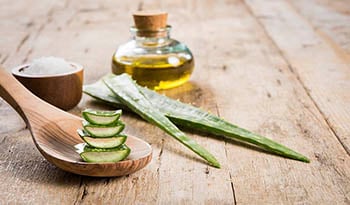The Best Natural Remedies for Managing Allergies and Asthma
DISCLAIMER:This blog does not intend to provide diagnosis...
- In this article:
- What Are Allergies?
- The Link Between Asthma and Allergies
- Combat Allergies and Asthma Naturally
- Allergy Hygiene: Reduce Exposure to Triggers
- Supplements and Nutrients for Improving Asthma and Allergies
- Takeaway

From the freshly blossoming flowers to the newly green grasses, springtime presents some unique challenges for those of us with seasonal allergies. And for people who suffer from non-seasonal allergies, the spring is a reminder of how much of our time is spent managing our own allergic symptoms.
Allergy symptoms are on the rise, according to the Asthma and Allergy Foundation of America. Between 1997 and 2011, the prevalence of allergies in children increased significantly. Allergies are now the sixth-most common chronic disease in the United States. So if you or a loved one happen to suffer from allergies, know you’re not alone!
Luckily, there are plenty of natural remedies available for you to help manage your symptoms. In this article, we’ll discuss the link between asthma and allergies and how you can use natural and lifestyle approaches to help heal and manage them so you can thrive!
What Are Allergies?
Allergies are defined as “disease following a response by the immune system to an otherwise innocuous antigen.” When you make contact with an allergen, your body reacts as though you have encountered something dangerous to your immune system. Technically, there shouldn’t be a danger there - but unfortunately, your body doesn’t know that.
According to Immunobiology: The Immune System in Health and Disease, “allergy is one of a class of immune system responses that are termed hypersensitivity reactions. These are harmful immune responses that produce tissue injury and may cause serious disease.” These harmful immune responses create symptoms like rashes, swelling, sinus pressure, or a runny nose—all of which feel pretty terrible!
To be more specific, the immune system produces antibodies to fight whatever danger it has identified. These antibodies—small proteins that help identify and fight pathogens invading the body—attach to cells called “mast cells” when the body first comes into contact with the allergen. The next time the body encounters that allergen again, the mast cells release chemicals like histamine, which is thought to be responsible for many of the allergy symptoms we know best—itchy eyes, watery or runny nose, hives, and more.
Histamine is a vasoactive chemical that “regulates a variety of physiological functions by playing a key role in the inflammatory response of the body.” Histamine is responsible for creating the most common allergy symptoms and is the target of many allergy medications. This is partly why allergy medications are often called “antihistamines.”
Histamines cause inflammation like skin swelling and blood vessels expanding. They can also increase the permeability of tissues and blood vessels, which results in the fluid-filled hives or runny noses we often see with allergies.
The Link Between Asthma and Allergies
Asthma and allergies are part of the allergic triad—the tendency of asthma, eczema, and allergies to coexist. Asthma and allergies involve many of the same immunological mechanisms, including cytokine release, IgE production, mast cell degranulation, histamine release, and more.
People with allergies are far more likely to experience asthma than those without allergies. Likewise, people with asthma tend to experience allergies more than the general population. Because these two disorders share many of the same mechanisms and origins, they are treated similarly using a natural and functional medicine approach.
Combat Allergies and Asthma Naturally
There are many dietary and supplemental approaches to healing allergies and asthma from the inside out. Here are some great ones to chat with your doctor about as you develop your asthma and allergy lifestyle plan.
Allergy Hygiene: Reduce Exposure to Triggers
If pollen and other allergens are triggers for your immunological dysfunction, asthma, or allergy, then the best medicine is to reduce the number of allergens you’re exposed to in the first place. Here are some of my favorite recommendations for minimizing the allergens in your environment.
HEPA Filter
HEPA stands for “high-efficiency particulate air [filter].” According to the United States Environmental Protection Agency (EPA), HEPA filters can capture up to 99.97% of dust, pollen, mold, bacteria, and any airborne particles with a size of 0.3 microns.
Most of these filters are designed to purify just one room, not an entire home. So purchasing one for a bedroom or a living area is a good choice. While the EPA does not certify air filters, they provide a list of guidelines to check out when deciding which one to purchase.
I recommend the regular use of HEPA filters in rooms where you spend the most time (bedroom, office, etc.) to clean the air of pollens and allergens so you can breathe more easily.
Reduce Dust and Pollen
There are a few other ways to help your home stay clear of allergens:
- Dust and vacuum regulary using a vacuum cleaner with a HEPA filter.
- Wash curtains, bedding, and more with hot water to kill dust mites.
- Brush your pets outside, if possible, to keep their dander under control, and avoid having pets in your bedroom at night to keep your sleep space free of unnecessary allergens.
Neti Pot
Neti pots are an excellent option for clearing mucus and pollens out of nasal passages, which can reduce symptoms of stuffiness and congestion. To use a neti pot, simply pour distilled water—and yes, it should definitely be distilled!—into the pot, then add a prepackaged saline solution that is designed for neti pots. The saline solution helps protect against nasal passage irritation.
Next, you place the “spout” of the pot into one nostril. Tilt your head (over a sink for easier cleanup!) and angle the neti pot up. Gravity will help pull the water/saline through one nasal passage and out the other.
The sensation can be a little uncomfortable at first, but neti pots are a great way to relieve nasal pressure, clean the nasal passage, and improve breathing without using any medication whatsoever. If you’re a neti pot enthusiast, you can purchase saline refills to keep your medicine cabinet well-stocked.
Supplements and Nutrients for Improving Asthma and Allergies
There are many evidence-based approaches to improving asthma and allergies using nutrients and supplements. Here are a few of my favorites.
Quercetin
Quercetin is a polyphenolic flavonoid that has anti-inflammatory properties. According to the NIH, it may also increase the number of mitochondria—the energy powerhouses of the cell—in muscle, reduce oxidative stress, and improve blood flow.
Quercetin helps stabilize mast cells and can reduce the amount of histamine our bodies produce in response to allergens. This, in turn, can help reduce symptoms.
Quercetin occurs naturally in fruits, vegetables, and even some beverages. For example, apples, onions, and black teas are all high in quercetin. You can consume quercetin as an individual supplement or as part of an anti-allergy blend.
Omega-3s
Omega-3s are fatty acids that may help calm the inflammatory processes that aggravate asthma. Eicosapentaenoic acid (EPA) and docosahexaenoic acid (DHA) are the two types of Omega-3s that are strongly anti-inflammatory and helpful for anyone suffering from allergies. EPA and DHA are most often found in fish, fish oil, and krill oil.
Stinging Nettle
Nettles have been used in indigenous medicine for hundreds—maybe even thousands—of years. Stinging nettles, specifically, have been found to have anti-inflammatory and antihistamine properties. You can consume them in the form of a supplement or as a tea or tincture. For more information on stinging nettle, you can read this great article.
Vitamin C
Vitamin C is a great option for combating allergy symptoms! Vitamin C is a potent antioxidant that works to protect cells from the damage caused by free radicals. Some studies have found a direct correlation between vitamin C and depressed histamine reactions in cells.
The human body can’t produce vitamin C on its own, so we need to ingest it. In addition to citrus fruits, bell peppers, kiwis, strawberries, and many other vitamin C-rich fruits and vegetables, you can also take this important vitamin as a supplement. Capsules are a good option when speed is of the essence, and gummies, lozenges, and powders are good choices for little ones who might actually like the taste!
Takeaway
You and your doctor have a wide variety of tools to use when it comes to treating asthma and allergies naturally. From allergen and pollen reduction to supplements and nutrients, these recommendations will get you feeling better this allergy season and beyond!
References:
- Janeway CA Jr, Travers P, Walport M, et al. Immunobiology: The Immune System in Health and Disease. 5th edition. New York: Garland Science; 2001. Chapter 12, Allergy and Hypersensitivity. Available from: https://www.ncbi.nlm.nih.gov/books/NBK10756/
- InformedHealth.org [Internet]. Cologne, Germany: Institute for Quality and Efficiency in Health Care (IQWiG); 2006-. Allergies: Overview. [Updated 2020 Apr 23]. Available from: https://www.ncbi.nlm.nih.gov/books/NBK447112/
- Patel RH, Mohiuddin SS. Biochemistry, Histamine. [Updated 2021 May 9]. In: StatPearls [Internet]. Treasure Island (FL): StatPearls Publishing; 2022 Jan-. Available from: https://www.ncbi.nlm.nih.gov/books/NBK557790/
- “Antihistamines.” National Health Service. https://www.nhs.uk/conditions/antihistamines/
- Yang L, Fu J, Zhou Y. Research Progress in Atopic March. Front Immunol. 2020;11;1907. Published 2020 Aug 27. doi:10.3389/fimmu.2020.01907
- “What is a HEPA Filter?” United States Environmental Protection Agency. https://www.epa.gov/indoor-air-quality-iaq/what-hepa-filter-1
- “Omega-3s Fatty Acids.” National Institute of Health: Office of Dietary Supplements. https://ods.od.nih.gov/factsheets/Omega3FattyAcids-HealthProfessional/
- Kregiel, Dorota et al. “Urtica spp.: Ordinary Plants with Extraordinary Properties.” Molecules (Basel, Switzerland) vol. 23,7 1664. 9 Jul. 2018, doi:10.3390/molecules23071664
- “Vitamin C.” National Institute of Health: Office of Dietary Supplements. https://ods.od.nih.gov/factsheets/VitaminC-HealthProfessional/#h13

 By Dr. Kate Henry, N.D.
By Dr. Kate Henry, N.D.


